Carob
The carob (Ceratonia siliqua) is a flowering evergreen tree or shrub in the legume family, Fabaceae. It is widely cultivated for its edible pods, and as an ornamental tree in gardens and landscapes. The carob tree is native to the Mediterranean region and the Middle East.[1][2]
| Carob | |
|---|---|
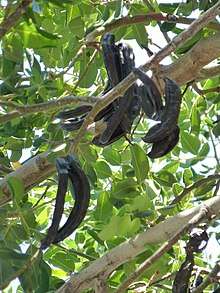 | |
| Carob pods on the tree | |
| Scientific classification | |
| Kingdom: | Plantae |
| Clade: | Tracheophytes |
| Clade: | Angiosperms |
| Clade: | Eudicots |
| Clade: | Rosids |
| Order: | Fabales |
| Family: | Fabaceae |
| Genus: | Ceratonia |
| Species: | C. siliqua |
| Binomial name | |
| Ceratonia siliqua | |
The ripe, dried, and sometimes toasted pod is often ground into carob powder, which is sometimes used to replace cocoa powder. Carob bars (an alternative to chocolate bars), as well as carob chips (an alternative to chocolate chips), and carob treats are often available in health food stores. Carob pods are naturally sweet, not bitter, and contain no theobromine or caffeine.
Etymology
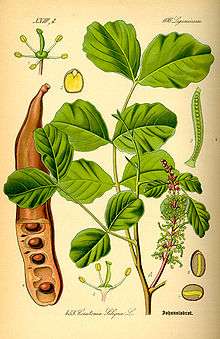
The word "carob" comes from Middle French carobe (modern French caroube), which borrowed it from Arabic خَرُّوبٌ (kharrūb, "locust bean pod"),[3] ultimately perhaps from Akkadian language kharubu or Aramaic kharubha, related to Hebrew harubh.[4] Ceratonia siliqua, the scientific name of the carob tree, derives from the Greek kerátiοn κεράτιον "fruit of the carob" (from keras κέρας "horn"), and Latin siliqua "pod, carob".
In English, it is also known as "St John's bread",[5][lower-alpha 1] as well as "locust tree",[7] (not African locust bean)[8] the designation also applied to several other trees from the same family.
The unit "carat", used for weighing precious metal and stones, also comes from κεράτιον, as alluding to an ancient practice of weighing gold and gemstones against the seeds of the carob tree by people in the Middle East. The system was eventually standardized, and one carat was fixed at 0.2 gram.
In late Roman times, the pure gold coin known as the solidus weighed 24 carob seeds (about 4.5 grams). As a result, the carat also became a measure of purity for gold. Thus, 24-carat gold means 100% pure, 12-carat gold means the alloy contains 50% gold.[9]
Carob tree
Morphology
The carob tree grows up to 15 m (49 ft) tall. The crown is broad and semispherical, supported by a thick trunk with rough brown bark and sturdy branches. Its leaves are 10 to 20 cm (3.9 to 7.9 in) long, alternate, pinnate, and may or may not have a terminal leaflet. It is frost-tolerant to roughly 20 °F (−7 °C).
Most carob trees are dioecious and some are hermaphroditic, so strictly male trees do not produce fruit.[10] When the trees blossom in autumn, the flowers are small and numerous, spirally arranged along the inflorescence axis in catkin-like racemes borne on spurs from old wood and even on the trunk (cauliflory); they are pollinated by both wind and insects. The male flowers smell like human semen, an odor that is caused in part by amines.[11]
The fruit is a legume (also known commonly, but less accurately, as a pod), that is elongated, compressed, straight, or curved, and thickened at the sutures. The pods take a full year to develop and ripen. When the sweet ripe pods eventually fall to the ground, they are eaten by various mammals, such as swine, thereby dispersing the hard inner seed in the excrement.
The seeds of the carob tree contain leucodelphinidin, a colourless flavanol precursor related to leucoanthocyanidins.[12]
Habitat
Although cultivated extensively, carob can still be found growing wild in eastern Mediterranean regions, and has become naturalized in the west.[13]
The tree is typical in the southern Portuguese region of the Algarve, where the tree is called alfarrobeira, and the fruit alfarroba. It is also seen in southern and eastern Spain (Spanish: algarrobo, algarroba), mainly in the regions of Andalusia, Murcia and Valencia (Valencian: garrofer, garrofa); Malta (Maltese: ħarruba), on the Italian islands of Sicily (Sicilian: carrua) and Sardinia (Italian: carrubo, carruba), in Southern Croatia (Croatian: rogač), in eastern Bulgaria (Bulgarian: рожков), and in Southern Greece, Cyprus, as well as on many Greek islands such as Crete and Samos. The common Greek name is χαρουπιά (translit. charoupia), or ξυλοκερατιά (translit. ksilokeratia, meaning "wooden horn"). In Turkey, it is known as "goat's horn" (Turkish: keçiboynuzu).[13][14]
The various trees known as algarrobo in Latin America (Albizia saman in Cuba, Prosopis pallida in Peru and four species of Prosopis in Argentina and Paraguay) belong to a different subfamily, Mimosoideae of the Fabaceae. Early Spanish settlers named them algarrobo after the carob tree because they also produce pods with sweet pulp.[15]
Ecology
The carob genus, Ceratonia, belongs to the legume family, Fabaceae, and is believed to be an archaic remnant of a part of this family now generally considered extinct. It grows well in warm temperate and subtropical areas, and tolerates hot and humid coastal areas. As a xerophyte (drought-resistant species), carob is well adapted to the conditions of the Mediterranean region with just 250 to 500 millimetres (9.8 to 19.7 in) of rainfall per year.[13]
Carob trees can survive long periods of drought, but to grow fruit, they need 500 to 550 millimetres (20 to 22 in) of rainfall per year.[13] They prefer well-drained, sandy loams and are intolerant of waterlogging, but the deep root systems can adapt to a wide variety of soil conditions and are fairly salt-tolerant (up to 3% in soil).[13] After being irrigated with saline water in the summer, carob trees could possibly recover during winter rainfalls.[16] In some experiments, young carob trees were capable of basic physiological functions under high salt conditions (40 mmol NaCl/l).[16]
Not all legume species can develop a symbiotic relationship with rhizobia to make use of atmospheric nitrogen. It remains unclear if carob trees have this ability: Some findings suggest that it is not able to form root nodules with rhizobia,[13] while in another more recent study, trees have been identified with nodules containing bacteria believed to be from the genus Rhizobium.[17] However, a study measuring the 15N-signal (isotopic signature) in the tissue of the carob tree did not support the theory that carob trees naturally use atmospheric nitrogen.[18]
Cultivation and orchard management
The vegetative propagation of carob is naturally restricted due to its low adventitious rooting potential. Therefore, grafting and air-layering may prove to be more effective methods of asexual propagation.[19] Seeds are commonly used as the propagation medium. The sowing occurs in pot nurseries in early spring and the cooling- and drying-sensitive seedlings are then transplanted to the field in the next year after the last frost. Carob trees enter slowly into production phase. Where in areas with favorable growing conditions, the cropping starts 3–4 years after budding, with the nonbearing period requiring up to 8 years in regions with marginal soils. Full bearing of the trees occurs mostly at a tree-age of 20–25 years when the yield stabilizes.[13] The orchards are traditionally planted in low densities of 25–45 trees per hectare. Hermaphrodite plants or male trees, which produce fewer or no pods, respectively, are usually planted in lower densities in the orchards as pollenizers.
Intercropping with other tree species is widely spread. Not much cultivation management is required. Only light pruning and occasional tilling to reduce weeds is necessary. Nitrogen-fertilizing of the plants has been shown to have positive impacts on yield performance.[13] Although it is native to moderately dry climates, two or three summers irrigation greatly aid the development, hasten the fruiting, and increase the yield of a carob tree.[20]
Harvest and post-harvest treatment
The most labour-intensive part of carob cultivation is harvesting, which is often done by knocking the fruit down with a long stick and gathering them together with the help of laid-out nets. This is a delicate task because the trees are flowering at the same time and care has to be taken not to damage the flowers and the next year's crop. The literature recommends research to get the fruit to ripen more uniformly or also for cultivars which can be mechanically harvested (by shaking).[13]
After harvest, carob pods have a moisture content of 10–20% and should be dried down to a moisture content of 8% so the pods do not rot. Further processing separates the kernels (seeds) from the pulp. This process is called kibbling and results in seeds and pieces of carob pods (kibbles). Processing of the pulp includes grinding for animal feed production or roasting and milling for human food industry. The seeds have to be peeled which happens with acid or through roasting. Then the endosperm and the embryo are separated for different uses.[13]
Pests and diseases
Only a few pests are known to cause severe damage in carob orchards, so they have traditionally not been treated with pesticides. Some generalist pests such as the larvae of the leopard moth (Zeuzera pyrina L.), the dried fruit moth (Cadra calidella), small rodents such as rats (Rattus spp.) and gophers (Pitymys spp.) can cause damage occasionally in some regions. Only some cultivars are severely susceptible to mildew disease (Oidium ceratoniae C.). One pest directly associated with carob is the larva of the carob moth (Myelois ceratoniae Z.), which can cause extensive postharvest damage.[13]
Cadra calidella attack carob crops before harvest and infest products in stores. This moth, prevalent in Cyprus, will often infest the country's carob stores. Research has been conducted to understand the physiology of the moth, in order to gain insight on how to monitor moth reproduction and lower their survival rates, such as through temperature control, pheromone traps, or parasitoid traps.[21]
| Carob production – 2017 | |
|---|---|
| Country | (tonnes) |
| 41,909 | |
| 28,910 | |
| 21,983 | |
| 15,016 | |
| 12,528 | |
| World | 136,540 |
| – FAO estimate Source: UN Food and Agriculture Organization[22] | |
Cultivars and breeding aims
Most of the roughly 50 known cultivars[13] are of unknown origin and only regionally distributed. The cultivars show high genetic and therefore morphological and agronomical variation.[13] No conventional breeding by controlled crossing has been reported, but selection from orchards or wild populations has been done. Domesticated carobs (C. s. var. edulis) can be distinguished from their wild relatives (C. s. var. silvestris) by some fruit-yielding traits such as building of greater beans, more pulp, and higher sugar contents. Also, genetic adoption of some varieties to the climatic requirements of their growing regions has occurred.[13] Though a partially successful breaking of the dioecy happened, the yield of hermaphroditic trees still cannot compete with that of female plants, as their pod-bearing properties are worse.[23] Future breeding would be focused on processing-quality aspects, as well as on properties for better mechanization of harvest or better-yielding hermaphroditic plants. The use of modern breeding techniques is restricted due to low polymorphism for molecular markers.[13]
Production
In 2017, world production of carob was 136,540 tonnes, led by Portugal, with 30% of the world total. Italy, Morocco, Turkey, Greece and Spain were the next major producers (see table).[22]
Uses
Food


Carob products consumed by humans come from the dried, sometimes roasted, pod, which has two main parts: the pulp accounts for 90% and the seeds 10% by weight.[13][24] Carob pulp is sold either as flour or "chunks".[24] The flour of the carob embryo (seed) can also be used for human and animal nutrition,[13] but the seed is often separated before making carob powder (see section on locust bean gum below).
Carob pods are mildly sweet on their own (being roughly 1/3 to 1/2 sugar by dry weight), so they are used in powdered, chip or syrup form as an ingredient in cakes and cookies, sometimes as a substitute for chocolate in recipes because of the color, texture, and rich taste of carob. In Malta, a traditional sweet called karamelli tal-harrub and eaten during the Christian holidays of Lent and Good Friday is made from carob pods.[25] Also, dried carob fruit is traditionally eaten on the Jewish holiday of Tu Bishvat.[26]
Locust bean gum
The production of locust bean gum (LBG), a thickening agent used in the food industry, is the most important economic use of carob seeds (and now the carob tree as a whole.) Locust bean gum is used as a thickening agent and stabilizer to replace fat in low-calorie products, or as a substitute for gluten. To make 1 kilogram (2.2 lb) of locust bean gum, 3 kilograms (6.6 lb) of carob seeds are needed, which must come from roughly 30 kilograms (66 lb) of carob pod fruit.
Locust bean gum is produced from the endosperm, which accounts for 42–46% of the carob seed, and is rich in galactomannans (88% of endosperm dry mass). Galactomannans are hydrophilic and swell in water. If galactomannans are mixed with other gelling substances, such as carrageenan, they can be used to effectively thicken the liquid part of food. This is used extensively in canned food for animals in order to get the "jellied" texture.[24]
Animal feed
While chocolate contains the chemical compound theobromine in levels that are toxic to some mammals, carob contains none, and it also has no caffeine, so it is sometimes used to make chocolate-like treats for dogs.[27][28][29] Carob pod meal is also used as an energy-rich feed for livestock, particularly for ruminants, though its high tannin content may limit this use.[30]
Historically, carob pods were mainly used for animal fodder in the Maltese Islands, apart from times of famine or war, when they formed part of the diet of many Maltese people. On the Iberian Peninsula, carob pods were historically fed to donkeys.
Composition
The pulp of a carob pod is about 48–56% sugars and 18% cellulose and hemicellulose.[13] Some differences in sugar (sucrose) content are seen between wild and cultivated carob trees: ~531 g/kg dry weight in cultivated varieties and ~437 g/kg in wild varieties. Fructose and glucose levels do not differ between cultivated and wild carob.[31] The embryo (20-25% of seed weight) is rich in proteins (50%). The testa, or seed coat (30–33% of seed weight), contains cellulose, lignins, and tannins.[24][32]
Syrup and drinks
Carob pods are about 1/3 to 1/2 sugar by weight, and this sugar can be extracted into a syrup.[33] In Malta, a carob syrup (ġulepp tal-ħarrub) is made out of the pods. Carob syrup is also used in Crete, and Cyprus exports it.
In Egypt, crushed pods are heated to caramelize its sugar, then water added and boiled for sometime. The result is a cold beverage, also called kharrub, which is sold by juice shops and street vendors, specially in summer.
Carob is used for compote, liqueur, and syrup in Turkey, Malta, Portugal, Spain, and Sicily. In Libya, carob syrup (called rub) is used as a complement to asida (made from wheat flour). The so-called "carob syrup" made in Peru is actually from the fruit of the Prosopis nigra tree. Because of its strong taste, carob syrup is sometimes flavored with orange or chocolate.
Ornamental
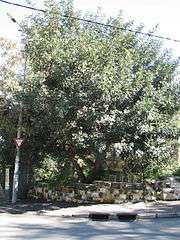
The carob tree is widely cultivated in the horticultural nursery industry as an ornamental plant for Mediterranean climates and other temperate regions around the world, being especially popular in California and Hawaii. The plant develops a sculpted trunk and the form of an ornamental tree after being "limbed up" as it matures, otherwise it is used as a dense and large screening hedge. The plant is very drought tolerant so (if one does not care about the size of the fruit harvest) it can be used in xeriscape landscape design for gardens, parks, and public municipal and commercial landscapes.[1]
Timber
In some areas of Greece, viz. Crete, carob wood is largely used as a fuelwood, being sold at fuelwood yards. It's a very good fuel and sometimes preferred over oak and olive wood. Because the much fluted stem usually shows heart rot it is rarely used for construction timber. However, it is sought for ornamental work sometimes and, since the natural shape of the fluted stem lends itself to it, specifically for furniture design. Given the sometimes extremely wavy grain of the wood that gives it very good resistance to splitting, sections of Carob bole are suitable for chopping blocks for splitting wood.
Gallery
 Male flowers on a carob tree in Cyprus, which emanate a strong cadaverine odor
Male flowers on a carob tree in Cyprus, which emanate a strong cadaverine odor Close-up of female flower on the carob tree
Close-up of female flower on the carob tree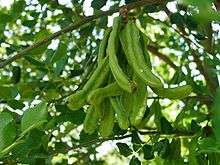 Green carob fruit pods on tree, 15 cm (5.9 in) long
Green carob fruit pods on tree, 15 cm (5.9 in) long Fruit of the carob tree
Fruit of the carob tree- Carob pods: green (unripe) and brown (ripe)
- Abaxial and adaxial surfaces of a leaflet from the carob tree
 Ceratonia siliqua wood - Museum specimen
Ceratonia siliqua wood - Museum specimen
See also
- Ratti (a seed from which the Indian measure unit "tola" derived)
Notes
- From the belief that the seeds and pulp were the "locusts" and "honey" eaten by John the Baptist[6]
References
- "Ceratonia siliqua". Germplasm Resources Information Network (GRIN). Agricultural Research Service (ARS), United States Department of Agriculture (USDA). Retrieved 11 December 2017.
- "Tropicos - Name - !Ceratonia siliqua L." tropicos.org.
- Oxford English Dictionary, 1st ed. (1888), s.v. 'carob'
- Harper D. "carob". Online Etymology Dictionary.
- ITIS Report Page: Ceratonia siliqua. accessed 5.11.2011
- Little, Elbert L. (1994) [1980]. The Audubon Society Field Guide to North American Trees: Western Region (Chanticleer Press ed.). Knopf. p. 488. ISBN 0394507614.
- Rehm S, Espig G (1991). The cultivated plants of the tropics and subtropics : cultivation, economic value, utilization. Weikersheim (DE): Margraf. pp. viii, 552 p. – p.220.
- Conder CR, Kitchener HH (1883). The Survey of Western Palestine: Memoirs of the Topography, Orography, Hydrography, and Archaeology. 3. London: Committee of the Palestine Exploration Fund., p. 354 s.v. Khurbet Jala
- Harper D. "carat". Online Etymology Dictionary.
- Adams P (14 April 2013). "Sweet Crop Broadcast". Landline.
- Armstrong WP (July 28, 2010), Malodorous Male Flowers Of Carob Tree (Ceratonia siliqua), retrieved November 17, 2017
- Gotfredsen E. "Leucodelphinidin". Liber Herbarum Minor (English): The incomplete reference-guide to Herbal medicine.
- Battle I, Tous J (1997). Carob tree (PDF). Rome, Italy: International Plant Genetic Resources Institute. ISBN 978-92-9043-328-6. Retrieved 2011-02-19.
- "Fruits". Turkish Cuisine. Archived from the original on 2011-07-28. Retrieved 2010-07-26.
- Valentin Calderon, Lionel. "Barrio Algarrobos" (in Spanish). Aquí Esta Puerto Rico.
- Correia PJ, Gamaa F, Pestana M, Martins-Loução MA (2010). "Tolerance of young (Ceratonia siliqua L.) carob rootstock to NaCl". Agricultural Water Management. 97 (6): 910–916. doi:10.1016/j.agwat.2010.01.022.
- Missbah El Idrissi M, Aujjar N, Belabed A, Dessaux Y, Filali-Maltouf A (1996). "Characterization of rhizobia isolated from Carob tree (Ceratonia siliqua)". Journal of Applied Microbiology. 80 (2): 165–73. doi:10.1111/j.1365-2672.1996.tb03205.x.
- La Malfa S, Tribulato E, Gentile A, Gioacchini P, Ventura M, Tagliavini M (2010). "15N natural abundance technique does not reveal the presence of nitrogen from biological fixation in field grown carob (Ceratonia siliqua L.) trees". Acta Horticulturae. 868: 191–195.
- Gubbuk H, Gunes E, Ayala-Silva T, Ercisli S (2011). "Rapid Vegetative Propagation Method for Carob". Notulae Botanicae Horti Agrobotanici Cluj-Napoca. 39 (1): 251–254. doi:10.15835/nbha3916074.
- Bailey LH (1914). The Standard Cyclopedia of Horticulture. The Macmillan Company. p. 718. Retrieved 23 November 2011.
- Cox PD (1975). "The influence of photoperiod on the life-cycles of Ephestia calidella (Guenee) and Ephestia figulilella Gregson (Lepidoptera: Phycitidae)". Journal of Stored Products Research. 11 (2): 77–85. doi:10.1016/0022-474X(75)90043-0.
- "Carob production in 2017; Crops/World Regions/Production Quantity from pick lists". UN Food and Agriculture Organization, Statistics Division. 2019. Retrieved 9 December 2019.
- Zohary D (2013). "Domestication of the carob (Ceratonia siliqua L.)". Israel Journal of Plant Sciences. 50 (supplement 1): 141–145. doi:10.1560/BW6B-4M9P-U2UA-C6NN.
- Droste R (1993). Möglichkeiten und Grenzen des Anbaus von Johannisbrot (Ceratonia siliqua L.) als Bestandteil eines traditionellen Anbausystems in Algarve, Portugal [Possibilities and limitations of the cultivation of locust bean (Ceratonia siliqua L.) as part of a traditional farming system in Algarve, Portugal] (in German). Institut für Pflanzenbau und Tierhygiene in den Tropen und Subtropen, Georg-August-Universität Göttingen: Goltze. ISBN 978-3-88452-743-6.
- Fenech N (2 April 2007). "Lenten treat: Carob caramel sweets". Times of Malta.
- Soloveichik M. "Why Jews Used to Eat Dried Carob on Tu b'Shvat". Mosaic. Retrieved 25 July 2017.
- Craig WJ, Nguyen TT (1984). "Caffeine and theobromine levels in cocoa and carob products". Journal of Food Science. 49 (1): 302–303, 305. doi:10.1111/j.1365-2621.1984.tb13737.x.
- Burg B (2007). Good Treats For Dogs Cookbook for Dogs: 50 Home-Cooked Treats for Special Occasions. Quarry Books. p. 28.
- Puotinen CJ (2000). The Encyclopedia of Natural Pet Care. McGraw Hill Professional. p. 81.
- Heuzé V, Sauvant D, Tran G, Lebas F, Lessire M (October 3, 2013). "Carob (Ceratonia siliqua)". Feedipedia.org. A programme by INRA, CIRAD, AFZ and FAO. Retrieved October 3, 2013.
- Biner B, Gubbuk H, Karhan M, Aksu M, Pekmezci M (January 2007). "Sugar profiles of the pods of cultivated and wild types of carob bean (Ceratonia siliqua L.) in Turkey". Food Chemistry. 100 (4): 1453–1455. doi:10.1016/j.foodchem.2005.11.037.
- Calixto, Fulgancio S (5 May 1982). "Components of Nutritional Interest in Carob Pods (Ceratonia siliqua)". J. Sci. Food Agric. 33 (12): 1319–1423. doi:10.1002/jsfa.2740331219.
- El Batal, H.; Hasib, A.; Ouatmane, A.; Dehbi, F.; Jaouad, A.; Boulli, A. (2016-11-01). "Sugar composition and yield of syrup production from the pulp of Moroccan carob pods (Ceratonia siliqua L.)". Arabian Journal of Chemistry. 9: –955–S959. doi:10.1016/j.arabjc.2011.10.012. ISSN 1878-5352.
External links
| Wikimedia Commons has media related to: |
| Wikispecies has information related to Carob |
| Wikisource has the text of the 1911 Encyclopædia Britannica article Locust-Tree. |
- Crops and recipes
- Carob recipes, Cooks.com.
- "Recipe for the Egyptian Carob Drink", Egyptian-cuisine-recipes.com.
- "Interview of Australian carob producers", ABC.
- Turnbull LA, Santamaria L, Martorell T, Rallo J, Hector A (September 2006). "Seed size variability: from carob to carats". Biology Letters. 2 (3): 397–400. doi:10.1098/rsbl.2006.0476. PMC 1686184. PMID 17148413. Lay summary – New Scientist (May 9, 2006).
- Tree and images
- Purdue Univ: Fruits of Warm Climates: Carob treatment - horticulture and cultivars, species and native habitat treatment,
- PFAF Plant Database: Ceratonia siliqua — Carob
- U.C.CalPhotos: Carob —Ceratonia siliqua — Photo Gallery
- Encyclopedia.com: entry for Carob
- ""Caroubier" ("The Carob Tree" - book)" (PDF). (1.32 MB) (in English)
- Leaves of carob tree, source of chocolate substitute, fight food-poisoning bacteria
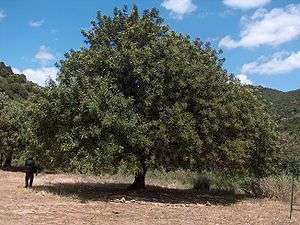
.jpg)